Huygens Anniversary Seminar
Day 5: Reach for Saturn
The Huygens Anniversary seminar has closed with an 'Open Day', presenting the Cassini-Huygens mission to a general audience. A few key speakers, historians, top level space scientists and managers of the Cassini-Huygens mission enthralled an audience of schoolteachers, students, amateur astronomers and a family public.
Explaining the activities of scientists is not easy. For a long time they had the reputation of living in ivory towers. That is certainly no longer the case and public outreach is an essential aspect of their work.
Today it is recognised that man's knowledge of his environment advances through careful observation, measurements and analysis. In a work published in 1623, Galileo Galilei declared that "the book of nature is written in the language of mathematics."
Indeed in the present day context, all the Saturn data from Cassini-Huygens will be beamed back to Earth in long computer files, strings of ones and zeros that will be converted into a greater understanding of the ringed planet, its rings and moons. Numbers however do not suffice.
Saturn picture power
The spacecraft has provided new images of Saturn but much of the adventure still has to be described in words and using artists' renderings. The full significance of a mission is better appreciated when it is accompanied by landscapes of these new worlds.
Based on current ground observations and analyses, different views of Titan's surface have been drawn: murky, cloud-laden skies, wind-driven showers of methane rain, spouting geysers, high mountains covered with water-ice, orange-tinted low plains and dirty hydrocarbon-filled craters.
But space art combines known facts and a fair dose of interpretation. The renditions could easily all be wrong but they will have served their purpose: firing and heightening the public interest.
Seeing Saturn as clearly as Jupiter
Another way of explaining the potential of a mission is by recalling previous space exploration achievements. The seminar was honoured by the presence of Torrance Johnson, former director of the Galileo mission to Jupiter.
Showing photographs obtained by the Jupiter probe, for example, of the moon Europa, zooming in on areas with increasing resolution reaching 6 metres for each recorded pixel, one could readily foresee the spectacular views that similar instruments on Cassini-Huygens will soon be sending back.
Time travelling
The joint European and American mission was also placed in its wider historical context. Several speakers recalled the perception of Christiaan Huygens who discovered Titan and whose understanding of the solar system led him to believe that life had to exist on other planets.
The 17th century astronomer had ventured so far as to say that such life would resemble ours, although he believed their inhabitants on Saturn or Jupiter would be like bats and owls since they are large and have so little light from the Sun.
Subsequent observations have revealed that conditions on Titan mirror those on Earth four billions years ago. Descending into Titan, the Huygens probe gives scientists the opportunity to travel back in time. Evocation of cosmic travel - even if it only concerns robots - and its relevance for our own planet Earth are also important in communicating to a wider public.
Inspiring the public
Representatives from NASA and ESA outlined their public outreach initiatives. In the field of education, it can be particularly effective. Primary teachers can, for instance, use space agency documentation to increase literacy. Children who can have considerable learning difficulties may be led to understand the characteristics of Saturn, and to draw and write about it with great talent.
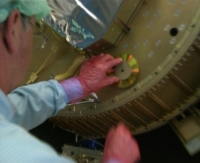 |
The seminar closed with a call to amateur astronomers not to lower their sights on Titan. The Cassini spacecraft will not be able to view Titan continuously during its four years around Saturn. Professional astronomers will still be using large ground telescopes to observe the planet. Although precision studies are probably impossible, relatively simple garden telescopes can still contribute valuable observation data on Titan such as on its changing atmosphere.
Day 4: The Mission
The scientists are bubbling with excitement and the public is being given a taste of things to come. Each week sees an Internet Status Update on the Cassini-Huygens mission. "The spacecraft is in excellent health and operating normally."
ESA and NASA websites are gearing up for what promises to be an exceptionally spectacular space mission - the first ever tour of the Saturn system. The latest pictures obtained by the joint European and American spacecraft show two of the planet's satellites, Pandora and Prometheus.
All systems aboard the Huygens probe have been checked and ESA's probe is prepared for its daring descent onto Saturn's largest moon Titan. All the orbiter's science instruments have been tested, many have been obtaining data for months, and all are ready for the Grand Tour of Saturn.
The fourth day of the Huygens Anniversary seminar has been devoted to performance of the science instruments, to the key flight manoeuvre that is fast approaching and to the genesis of the mission. Science managers, principal investigators, and founding fathers have all been making presentations.
"Ever since the Voyager flybys of Titan, we had been determined to get back there to see things closer," explained Tobias Owen. Together with Frenchman Daniel Gauthier and Chinese astronomer Wing Ip (at the time working in Europe), they drew up the proposal for a joint NASA-ESA mission to Saturn that was submitted to ESA in November 1982. Twenty-seven scientific teams had contributed.
All speakers have stressed the importance of the international cooperation for the programme. The partnership, with the constitution of multi-national teams, has ensured that the best science would be done. Many instruments provided by the United States have a majority of European investigators and vice-versa.
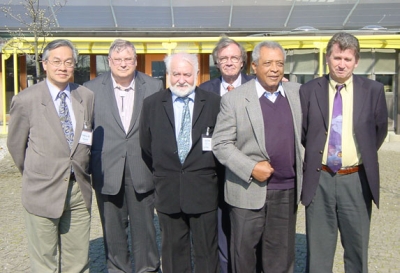 |
|
Cassini-Huygens key players (from left to right): Wing Ip, Dennis Matson, Daniel Gauthier, Tobias Owen, George Scoon, Jean-Pierre Lebreton |
The next key rendezvous
Everyone recognises that the firing of the Cassini's main engine on 1 July to go into orbit around Saturn (SOI) will be a crucial moment. Flight controllers at NASA JPL and Cassini project scientist Dennis Matson are confident.
"All aspects of the spacecraft have been checked out many times, our systems are all fully redundant and flight proven. We will be following the same paths as the Pioneer 11 and Voyager 2 craft and so we are not afraid of passing through the rings." Confidence is such that Matson prefers to joke with his Huygens counterpart Jean-Pierre Lebreton about the danger of eventual sharks in the hydrocarbon seas on Titan.
Reconnaissance observations for Huygens
The first moments of excitement, however, will come on 11 June when the spacecraft flies by Saturn's most distant moon Phoebe. Robert Brown, Principal Investigator for Cassini's Visible and Infrared Mapping Spectrometer (VIMS) made everyone's mouth water. "We will be so close, less than 2000 km, that this small satellite will fill up the whole sky."
When passing Titan, VIMS will provide a 1 km resolution. "If there are windows in the atmosphere, we may even see down to the surface and we expect a high probability of doing some geology." The instrument will also provide high resolution scans of the rings and Saturn's atmosphere.
The two cameras of the Imaging and Science Subsystem (ISS) instrument on Cassini will have a crucial role on the first Titan flybys (T0) on 2 July, immediately after Saturn insertion. The giant moon will then be about 330 000 km away.
"The ISS instrument has been targeting Titan since 2 April," says Robert West. "During these months prior to SOI, it will search for contrasts in the stratospheric haze and for clouds in the moon's lower atmosphere. Determination of winds from these measurements will provide data useful for the Huygens descent."
Another instrument, the Composite Infrared Spectrometer (CIRS, pronounced 'Sears') has been making observations of Saturn and its rings since February this year. It will also help Huygens by mapping the temperatures in Titan's stratosphere on the T0 flyby. These temperature-pressure profiles will help validate the atmospheric model used to plan the Huygens entry.
Already a stready stream of data
Presentations have featured pictures, spectra, graphics and flight trajectories for the Grand Saturn Tour, as well as some photographic recollections of the mission's earlier days. One speaker offered the seminar audience its first ever taste of the "sounds of Saturn".
The high-pitched warbling noises were from Cassini's Radio and Plasma Wave Science (RPWS) instrument. It has been 'listening' to the electric and magnetic components of such waves coming from Saturn since April 2002.
The Cassini orbiter has not yet arrived and the Huygens probe has still to discover Titan, but this mission is already providing the scientists with many new insights into the Saturnian system.
"I think we are going to have enough data to work on for some 25 years," said one participant. "We should already schedule another seminar to present our results, and to celebrate the 400th birthday of Christiaan Huygens."
Day 3: Gearing up for Titan
In a few months and over the next few years, our knowledge about Saturn, its rings and cohort of satellites will be making leaps and bounds. The world will have all eyes on the space probe arriving "on site", circling the planet and landing on its biggest moon Titan.
The Cassini-Huygens spacecraft has been travelling six and a half years. The destination is in sight, and increasingly vivid pictures are being sent back even before the joint European and American mission goes into orbit.
Scientists have pursued their observations at a distance. Ground telescopes are gleaning much information, some of it being used to fine-tune the mission. Excitement is mounting at the prospect "of being there".
Shrouded in its opaque hazy orange atmosphere, the shy giant Titan still retains all its mystery. In January 2005, the European Huygens probe will descend through the murk and either land on a solid surface or sink into liquid hydrocarbons.
A planet-sized laboratory
As was amply demonstrated during the third day devoted to recent scientific results, Titan is a planetary scale laboratory to learn more about our own Earth as it was 4 billion years ago. Analysis of infrared data provided by NASA's Voyager probe, from ESA's ISO space observatory and several ground telescopes is providing clues on the composition of Titan's atmosphere.
The main constituent of the moon's atmosphere is nitrogen but its origins are unclear. Methane is circulating there, breaking up under the effect of light as it reaches higher levels. The presence of water vapour has also been detected. Yet many questions remain.
With so much nitrogen, where is all the carbon on Titan? Where does the methane come from? Where is the waterice that must exist? Why do high altitude clouds appear and disappear? What importance are the thick layers of aerosols? It is a huge puzzle with chemical processes involving a hundred constituents and three hundred different chemical reactions.
Titan occasionally smiles with an enigmatic bright crescent around its South Pole. All ground-based and space borne telescopes show sharp differences on its surface.
Radar investigations have been conducted. Signals, practically one mega-watt strong, have been fired from the Arecibo radio transmitter dish in Puerto Rico towards the distant moon. They have bounced off Titan and returned to Earth two hours later ever so faintly, the equivalent of the amount of light that falls on the human retina in one second!
Sufficient information however has been obtained to confirm the observations at infrared wavelengths. But what do the bright as opposed to dark regions correspond to? Mountains, methane lakes, waterice, quantities of ammonia?
Everyone can fantasise on these expanses of oily liquid. Winds on Titan can be very strong. Big waves may be being whipped up, and tidal phenomena present. If so Titan's orbit would be more circular and less elliptic. Simulations have been conducted with trays of kerosene in a wind tunnel to understand what may be occurring.
Underground methane factories
The Titan laboratory is not a closed flask. Methane, which has a life duration of only 50 million years, is constantly leaking into space. Considerable quantities must therefore exist somewhere to top up the system. Hydrocarbon seas may be such reserves, perhaps underground reservoirs.
The physical and chemical processes on Titan are of considerable importance. Not just for astronomers trying to understand the mechanisms that led to the creation of the planets, but to fellow astro-biologists.
Since the early 1950s, scientists have worked on recreating in their laboratories the conditions that lead to the appearance of organic compounds, then macromolecules capable of self-replication.
Researchers in this field are wary about using the term "life", easily misconstrued by a wider public. The planetary freezer conditions on Titan today are very different from the times when life forms evolved on Earth.
Yet all the basic ingredients are present. So with a smile one can wonder whether there 'methanogen producers' deep in the moon's interior, peddling to pump the gas up to the surface? Are pre-biotic organic processes producing the methane? Life, although not very likely, cannot be ruled out.
30, 31, 32… counting the moons
Planetologists are interested in Saturn to understand how the different elements have come together to form a giant ball of swirling helium and hydrogen gas. When the Cassini orbiter is observing at close quarters, there will be an abundance of data. For example, about where the oxygen comes from: interplanetary dust, comets plunging in (as Shoemaker-Levy did on Jupiter in 1994), or from Saturn's small icy moons.
At the last count Saturn has 31 natural satellites. But the search goes on, with new 'moon candidates' being regularly discovered. Some are distant objects in the lost suburbs of Saturn, up to 23 million kilometres away. they take four years to orbit the planet and can be as small as 30 km.
Other objects, whose nature is still to be determined, are being found near and in the rings of Saturn. They may be the result of particles and blocks of icy material being clumped together to form moonlets, or they could be meteoric intruders caught by Saturn's attraction.
The Cassini orbiter will cast much light on the sparkling rings of the planet. There will be some forty flybys of Titan, and many other moons will be examined at close quarters during the four-year Saturn Grand Tour.
In the coming months, many issues will be settled. "It is a race against time," laughs one Titan expert. "I have the fear that in a few months I may become redundant. But on the other hand, we're only landing in one place and there is an entire new world to explore."
One participant at the third day of the Huygens Anniversary seminar summed up their common efforts and the present excitement. He did so by quoting from Christiaan Huygens: "It is the search itself that rewards the pains."
Day 2: Facets of the man Huygens
The Christiaan Huygens seminar taking place at ESA's Research and Technology Centre ESTEC in the Netherlands has celebrated the Dutch astronomer's birthday with a full day's evocation of the work and character of the Dutch astronomer, and an anniversary dinner.
The life of Christiaan Huygens, son of a wealthy statesman at the Court of The Hague, is well documented from his very first day. His father Constantijn Huygens had noted the precise time and circumstances of his son's birth - as he had done for his other children.
As a youngster, Huygens had enjoyed drawing and building models. But the mechanics of lathes and windmills were not to the taste of his father - such activities should not sidetrack his children from studying law and pursuing the noble family tradition of government service. Mathematics and science were viewed as hobbies for men of leisure. But Christiaan considered them as the keys to a new world. The science he liked was stimulated by important practical questions.
After studies at the University of Leiden and as an independent scholar, Christiaan Huygens found his new worlds by unveiling the secrets of the night sky. He was very adroit in the field of mechanics, and even went as far as suggesting that things that cannot be explained by mechanics do not belong to the realm of physics.
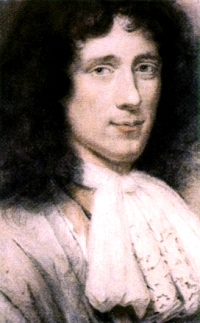 |
|
Portrait of Christaan Huygens |
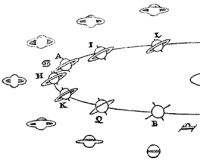 |
|
Sketch from Systema Saturnium |
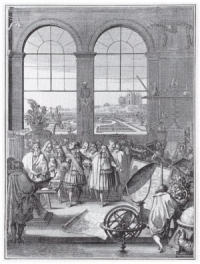 |
|
Engraving of Académie Royale Paris |
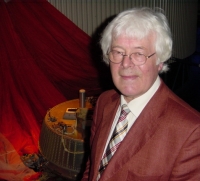 |
|
Cees D. Andriesse, biographer of Christiaan Huygens, who gave the anniversary diner speech: "Moon number 4 should have been named Huygens" |
A name for Saturn's moon
Visible to the naked eye, the sparkling singularity of Saturn had been noted as early as 3000 B.C. Until the 17th century and the invention of the telescope, the planet had been considered as a wandering star. After Galileo's identification of the planet's puzzling "ear-like lobes" which periodically disappeared, Christiaan Huygens provided the answer using a 23-foot long telescope that could magnify objects 50 times.
On 13 June 1655 he discovered what we now know to be Saturn's largest satellite. But fearing that he might be mistaken in his observation, he did not immediately disclose the discovery. Recalling this moment in his later years, he evoked "how great the joy of heart must be of him who sees things first."
Over the next 30 years the number of moons around Saturn grew to 5 (the other four being discovered by Cassini) and were designated by Roman numerals in order of the distance from the parent planet. Huygens' moon was in position number four.
In 1789 William Herschel observed two more moons orbiting inside the orbits of the other moons. This either meant a complete renumbering of all the moons, or having moons VI and VII being inside moons I to V. After the discovery of an eighth moon out of sequence William's son John came up with a solution that is still in use today - give all the moons a name. For Saturn John Herschel decided to use names connected with the god Saturn in Greek mythology. Huygens' moon was named Titan.
Four years after discovering Titan, Huygens' patient observations allowed him to understand the geometry of the planet's rings. His interpretation was not immediately accepted. Rival astronomers alleged that Huygens' lenses were not as superior as he claimed. He was challenged to a 'telescope duel' - and won!
Christiaan Huygens was also much absorbed in mathematics. In calling his son "my Archimedes", Constantijn Huygens had recognised his son's approach to mathematical thinking that stayed with him throughout his career.
To understand, for instance, the movement of multi-sided objects rolling more or less smoothly or how to calculate areas under a curve, Christiaan drafted his problems on paper with an exquisite hand. In such drawings he "represent the unrepresentable".
He studied time in the most practical way, building clocks and conceived the pendulum clock. He developed marine timekeepers that could assist sailors in determining their longitude. His clocks could have an accuracy, after 4 months at sea, of one degree, equivalent to 110 km.
Drawing his many loves
Christiaan Huygens's life in Paris from 1666 would be as rich as his years in Holland. From the affluence of his family home, he was summoned to work for Louis XIV. He only accepted when he obtained the due advantages: a yearly income that was six times the sums given to French colleagues!
During his years in France, Christiaan became enamoured with a certain Marianne Petit. "A beauty nicer than any portrait I could draw". Yet he was to remain a solitary man. His contemporaries accepted that as much as he might be fond of women, he was not a man to raise a family. His mind was often elsewhere.
In one of his later works, Huygens imagined how men "might rise from this limited Earth, and looking from above, travel in other far away lands, and form a judgement about things at home."
The words resound with foresight, anticipating modern day preoccupations. Using telescopes and lenses of his own design, he drew pictures of the planets, calculated their sizes and rotation periods, and identified the Martian polar cap or the shadows on Jupiter.
When one juxtaposes such drawings with views obtained more recently, with much more powerful and precise instruments, one cannot fail to be impressed by the life and work of this eminent European astronomer and man of science.
Day 1: Stressing Perseverance in Science
The years pass and man will go to great pains to understand his immediate surroundings and more distant worlds. Projects, often considered extravagant, can be nursed for years before leaving the cradle. Journeys cover hundreds of millions of kilometres before reaching their goals.
Patience and perseverance in space science exploration were recurring themes during the opening session of a seminar taking place in the Netherlands this week. Leading scientists studying Saturn have gathered as the Cassini-Huygens space probe approaches the planet and its moons.
Historians are also present as the seminar celebrates the 375th birthday of Christiaan Huygens, the eminent 17th century Dutch scientist and astronomer who discovered Titan, the largest of the ringed planet's natural satellites.
In her opening speech, Mrs Maria van der Hoeven, Dutch Minister for Culture, Education and Science recalled that Christiaan Huygens had postulated that life on other planets would require the presence of water. "Considering the recent discoveries on Mars, one sees that much time passes before theories are confirmed," said the Minister.
"Science must be considered on the long term… there must be room for crazy ideas if one is to increase our knowledge of the Universe," said Mrs. van der Hoeven. "Europe can stay at the forefront of innovation and science if we have the courage to face the challenges."
Words to the heart of ESA's Director-general Jean-Jacques Dordain who had welcomed the Minister to the European Space Agency's Research and Technology Centre (ESTEC) in Noordwijk, and who thanked the Dutch government for its continuous support.
M. Dordain singled out three aspects of Huygens' life. "He used the most advanced tools of his day to push back the frontiers of knowledge, he contributed to the construction of Europe… and he and I were both born on 14 April!"
Huygens' scientific revolution
Professor Floris Cohen, science historian at the University of Twente (NL), explained how Christiaan Huygens had followed in the footsteps of Galileo, examining new problems in a piecemeal way. Yet he had managed to reconcile this with the manifestly incompatible Cartesian approach that advocated seeing the world as a whole. "Unwittingly Huygens helped transform natural philosophy in a revolutionary manner, and he did so like a virtuoso."
It was a perfect cue for the first of two intermezzos. Baroque double harp, chitarrone, baroque guitar and bass singer enveloped the assistance in a 17th century atmosphere of Latin psalms, Italian madrigals and French songs, including music written by Christiaan's father, Constantijn Huygens.
Roger-Maurice Bonnet, ESA's former Director of Science, (himself an accomplished musician) then recalled the laborious conception of the joint European and NASA Cassini-Huygens mission to Saturn.
It has been, he said, one of the most complex interplanetary missions ever undertaken, with an exemplary cooperation between Europe and the United-States. Yet it had not been on a fast track.
"The first call for ideas was in 1982, and we will be landing our 'flying saucer' on Titan in January 2005. Twenty-three years to get there isn't necessarily a good model, particularly if one compares with today's projects. Venus Express, decided in 2002, will arrive in 2006."
Jean-Pierre Lebreton, ESA project scientist for the Huygens probe chided M. Bonnet. "It could be considered that taking twenty-three years isn't really that long in order to see what Earth might have been like 4 billion years ago!"
In Voyager's footsteps
In the early '80s, the Voyager 1 & 2 spacecraft had sent back pictures as they passed Titan, but shrouded in its thick orange-coloured hazy atmosphere, the moon had not revealed much.
However, NASA's Voyager odysseys with six planetary fly-bys were resounding successes, as French astronomer André Brahic vividly recalled.
"The Voyager missions also required some twenty years of preparation. What they discovered was immense in diversity and richness, and surpassed four centuries of Earth observations. We always expected the unexpected and we were never disappointed."
As the Cassini mother-ship and its piggyback passenger close in on their targets, all those present at the seminar are in the same mood, confident that years of preparation for such a long journey will soon bring its rewards. And the tribute to Christiaan Huygens could not be better: to have ESA's probe landing on Titan 350 years after he discovered it.
